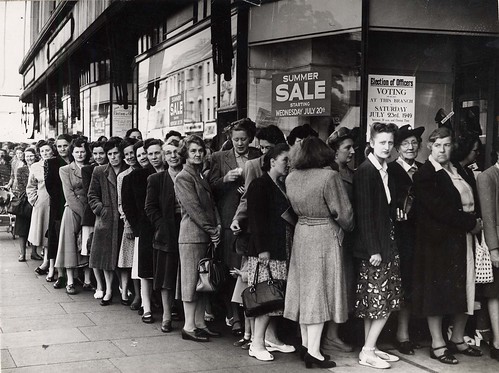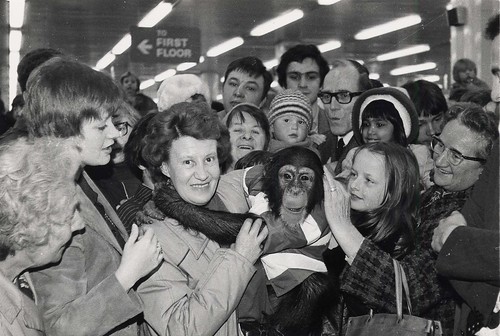For personal reasons, I have a great interest in the history of the Co-operative Society and so was delighted to recently discover the Bishopsgate Institute's archive of photos of the London Co-operative Society.
I was even more tickled to find some that show the Co-op in Wood Green, including this row of formidable ladies queuing in 1949.

Note the mention of the Election of Officers in the notice in the window. Each society had a board of directors elected by the members, anyone could vote provided they had a share number and anyone could stand for the Board. These ladies, I'm guessing, would be queueing to collect their 'divi' (5p in the £1, when I was a kid). The sale would be to encourage to spend back in the shops
Also some of their daughters (?) meeting a chimpanzee in 1975 at a Wood Green Shop Opening. Was this as part of the opening of Shopping City?

These are question for our long time residents of Harringay, I guess, but where were the nearest Co-ops to here? Where were the Wood Green shops situated? Any memories of the Co-op or the Co-operative Movement in the area? Was anyone a member of the Women's Guilds, the Education Committees or other activities? All contributions, no matter how small appreciated.
Short history of the London Co-operative Society from the Exploring 20 Century London website
The London Co-operative Society covered the London area and parts of adjoining counties. At the height of its operations, it was the largest co-operative in the UK. The society was created by the amalgamation of the Stratford Co-operative Society and the Edmonton Co-operative Society. Later a number of other local co-ops were incorporated from the London, Essex, Surrey, and Hertfordshire areas.
The modern co-operative movement has its origins in the activities of the Rochdale Pioneers in 1844. The object of co-operatives is for people to form voluntary associations in order to work together to further their own economic and social interests. This aim is to be achieved through a jointly-owned, democratically-controlled entity. The examples best known today are probably the Co-op chain of supermarkets and Co-op funeral directors. Historically one of the ways in which co-ops rewarded their members was with the dividend or ‘divi.’
In common with other co-ops, the LCS engaged in a wide variety of commercial activities. Retail outlets included the first self-service food shops in London, and ranged from department stores and supermarkets to small butchers’ and grocers’ shops. Chemists, laundries, funeral directors, and estate agents were also major areas of activity.
The LCS was also active politically and was involved in the Co-operative Party, founded in 1917. An alliance between the Co-op and Labour Parties was formed in 1927 and still exists today. The Society also supported a number of causes such as the Campaign for Nuclear Disarmament, the movement against the Vietnam War, and campaigns for solidarity with striking workers.
The Society ceased to exist in 1981 when it amalgamated with the Co-operative Retail Society.
see also Wikipedia
Tags for Forum Posts: Co-op, London Co-operative Society
Replies to This Discussion
-
I get the impression, with its Grammar School and Grand Parade, that Harringay was quite Tory.
-
-
Well, it certainly returned Tory councillors until Edith Summerskill but I have also found evidence of pockets of socialist subversion based in Harringay, anti-war movements and that sort of thing. Rather like today, difficult to pin down politically I'd say.
-
-
The Wood Green CO-OP was in Shopping City after it opened, but I can't remember exactly where it's predecessor was located.. somewhere quite near I suspect, although CO-OPs were generally a bit off the beaten track, because, I presume, they didn't want to pay the higher rents of the High Streets.
The original Tottenham CO-OP building still exists on the corner of Lansdowne Road, but re-located in the early 1970s after Burgesses, Tottenham's biggest dept store, closed down. (Ward's & Rudd's were at Seven Sisters (Wards) Corner)
@John Tottenham and Hornsey were both mostly working class, but both considered themselves one rung up the ladder from Hackney and Stoke Newington. Hornsey residents thought themselves (and still do) consider themselves 'better' than the Tottenham rabble..
Both Tottenham & Hornsey were tory working class - sort of new labourish with a sprinkling of socialists..
My Tottenham family were self-employed, ran their own business and voted tory.. but were definitely from a working class background -
-
As an afterthought, I suppose I'm looking at this from my family perspective. Tottenham had Labour MPs.. but there were definitely tory enclaves within it..
-
-
The Co op Wood Green used to be on teh corner of Lymington Avenue where the sports wear shop is now.
You had to pay for items by section. I remember being with my mother and having to queue several times for clothes, food etc - not very efficient. -
-
and don't forget your divi number.. :o)
-
-
My wife agrees with Lesley's siting on Lymington corner: "in the late 70s/early 80s before Toys'r'Us etc." But as Steve says it must have become part of the Shopping City soon afterwards
I have a ghostly memory of a small Harringay Co-op shop in the late 70s on one of the Parades (west side), maybe between present Baldwins and Pemberton jct. Am I dreaming?
An old neighbour of a Nigerian friend of ours then (late 80s) living on Perth Road, off Lordship Lane, remembered a WW2 bomb taking out their Co-op grocery and other houses somewhere between Perth Rd jct and Lordship Primary school. Probably flats now. -
-
Thanks Steve, now I remember where I saw the Co-op on a building recently. The sign is still there at Landsdowne rd. Think it says 1931. Where did the Tottenham co-op relocate to? The Co-op were often owners of the land their stores stood on, they own lots of land around Ipswich which they lease to developers. Not sure about the London Co-operative society.
Thanks Lesley and OAE for the info on Wood Green. Doubt there is any physical signs of it left then.
We kids had to learn the divi number. My Mum's is 115, because she took it over after my great grandad died. The divi was a great way to keep people loyal. Most societies did away with it, a great mistake. Many families appreciated a cash payout, stamps and points made the store no different from any other. The co-op also suffered from shopping snobbery. If you thought you were moving up in the world, you switched to Sainsbury's - still a dirty word for my family. Yet the Co-op led the way (thanks to its sneaky socialism ) in ethical trading, packaging etc.
These days certain parts do well e.g. Banking but the days of the department stores are gone. The large one in Ipswich was one of the last, and has now closed. There was an element of a store behind the Iron Curtain about it but at one time you could do everything from buy food to getting your eyes tested all in the one massive labyrinthine store. -
-
The Co-op in Tottenham relocated to Burgesses Department Store.. built 1922!
now the site of this!
Tottenham & Hornsey & Edmonton were all borderline places.. for instance they had LCS London Co-ops, Eastern Electricity & Eastern Gas..
Ponders End, Palmers Green & Enfield were in the Enfield Highway Co-op area, with Eastern Electricity, and Eastern Gas.
Stamford Hill & Stoke Newington had LCS Co-ops but were served by the LEB London Electricity & North Thames Gas..
All very complicated.. -
-
An Aldi. Then I wonder if the land was bought and is still owned by the Co-op. They did a deal with Aldi and now you often find the two grocery stores side by side or an Aldi on a former Co-op store site
-
© 2025 Created by Hugh.
Powered by
![]()


